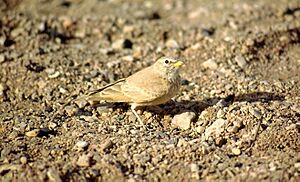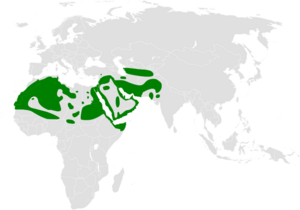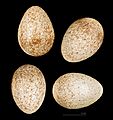Desert lark facts for kids
Quick facts for kids Desert lark |
|
|---|---|
 |
|
| A desert lark in Israel | |
| Conservation status | |
| Scientific classification | |
| Subspecies | |
|
See text |
|
 |
|
| Where the desert lark lives | |
| Synonyms | |
|
The desert lark (Ammomanes deserti) is a small bird that lives in deserts and dry, sandy places. You can find it in many parts of the world, from Morocco in Africa all the way to western India in Asia. This bird is doing very well! It has a huge home range, and its numbers are actually growing. Because of this, experts say it is a "least concern" species, meaning it's not currently in danger.
Contents
About the Desert Lark
The desert lark is a type of lark, which is a family of birds known for their songs.
What's in a Name?
When the desert lark was first discovered, it was put into a different bird group called Alauda. Later, scientists decided it fit better in the group Ammomanes. Sometimes, people also call it the "desert finch lark" or "sand lark."
Different Kinds of Desert Larks
Did you know there are many different kinds of desert larks? Scientists have found 22 different types, called subspecies. These subspecies look a little different depending on where they live. For example:
- The Southern Moroccan desert lark (A. d. payni) lives in southern Morocco.
- The Middle East desert lark (A. d. isabellina) is found from northern Egypt to places like Turkey and Iraq.
- The Indian desert lark (A. d. phoenicuroides) lives in parts of Afghanistan, Pakistan, and India.
Each of these subspecies has slightly different colors or markings that help them blend in with their specific desert homes.
What Does It Look Like?
The desert lark is a medium-sized bird. It is about 16 to 17 centimeters (about 6 to 7 inches) long. It has a big head and a long beak. Both male and female desert larks look very similar.
Its feathers can be different shades, from very light to quite dark. This helps them match the sand or rocks where they live. Birds living in sandy areas might be lighter, while those in rocky areas might be grayer. Some desert larks even have a reddish-brown color on their wings and tail. Their belly is usually a pale pinkish-gray.
Its Song
The desert lark has a sad-sounding song that goes choo-wee-chacha wooee. It sings from the ground, a rock, or while flying in a wavy pattern. When it gets scared and flies away, it makes a short churree or chee-lu sound.
Where Does It Live?
The desert lark lives in dry, stony areas. It avoids flat, open sand. You will usually find it in places with hills, rocks, or uneven ground. It lives in many countries, from Mauritania in Africa, across North Africa, and through the Middle East to western India.
These birds usually stay in one place and do not migrate (travel long distances) like some other birds. They only move around locally to find food or better shelter.
How Does It Live?
Desert larks are not very social birds. You usually see them alone or in small groups, not in big flocks.
Nests and Eggs
When it's time to have babies, desert larks become territorial. This means they protect their nesting area. They build their nests on the ground, often hidden under a bush or a stone. The nest is a shallow dip in the ground, lined with plants. Sometimes, they even put small pebbles around the edge of the nest to protect it.
A female desert lark usually lays 1 to 5 eggs. The time they lay eggs can be different depending on where they live. For example, in southern areas, they might lay eggs in January or February, but in northern areas, it might be March or April.
What Do They Eat?
Desert larks eat both seeds and insects. During the breeding season, when they need extra energy for their babies, they eat more insects.
Gallery





